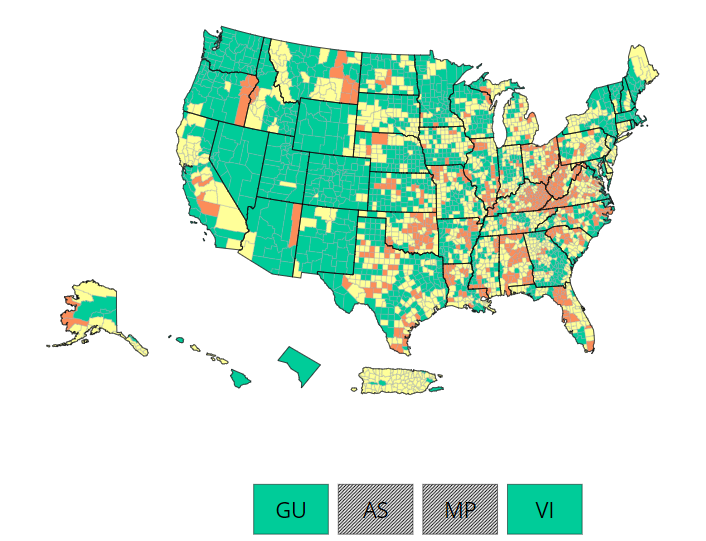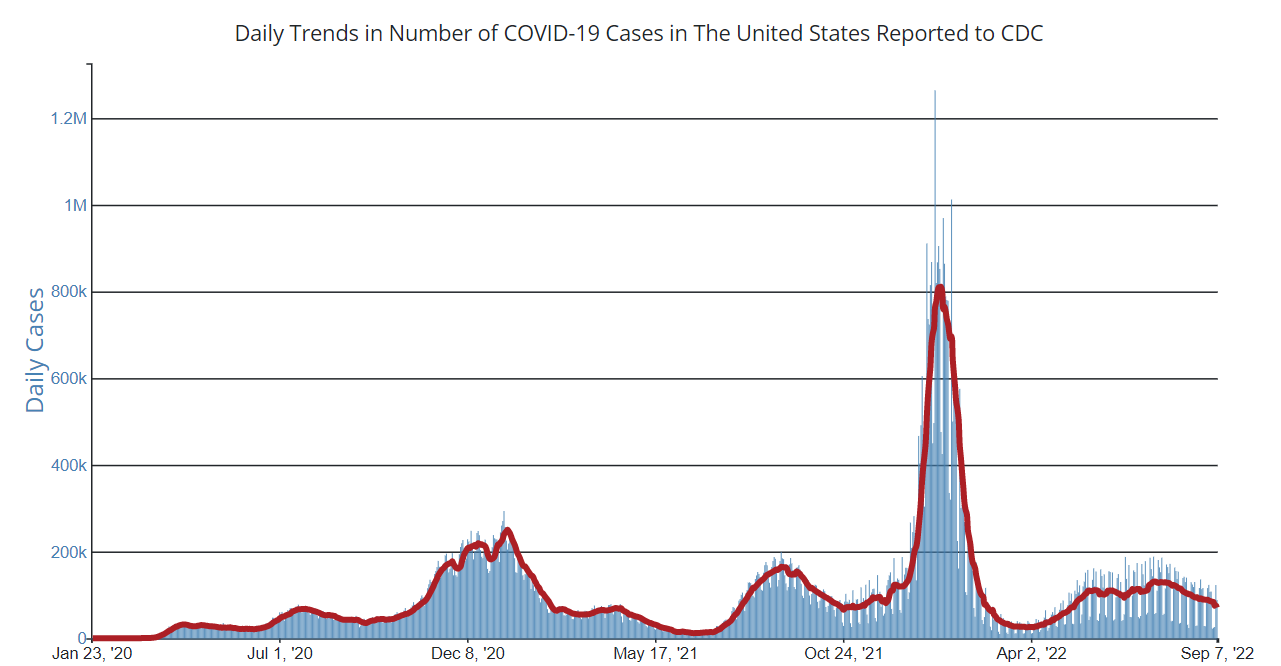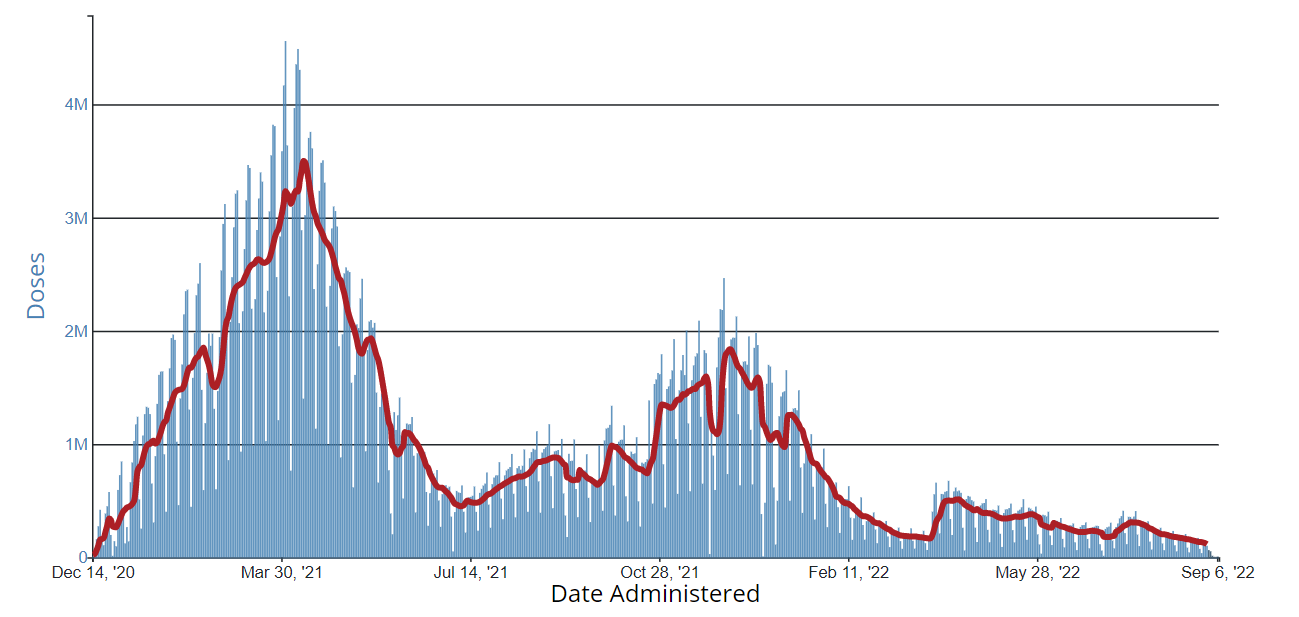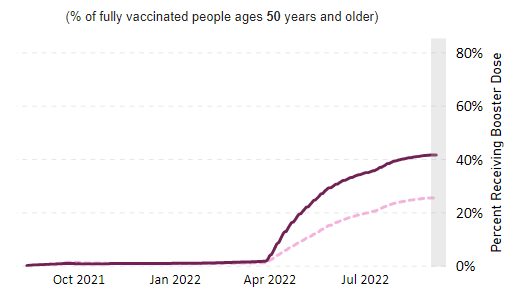Recommendations for Fully Vaccinated People
COVID-19 Homepage
Fall Boost
Interpretive Summary for September 9, 2022
Fall Boost
On September 1, CDC recommended that everyone ages 12 years and older in the United States receive an updated COVID-19 booster before a possible surge in COVID-19 illnesses later this fall and winter. Like the original boosters, the updated doses help restore protection that might have gone down since your last dose—but they also give extra protection for yourself and those around you against the most recent variants.
The updated booster is a bivalent vaccine because it targets two Omicron subvariants: BA.4 and BA.5. These newest subvariants are more contagious and able to evade protection that your body might have against earlier subvariants. Data suggest that the updated boosters also increase our immune response, which will help protect us against future variants.
Being up to date with COVID-19 vaccines is the best way to protect against severe illness, hospitalization, and death associated with COVID-19. Everyone who is eligible―including those who are moderately to severely immunocompromised―is recommended to receive one dose of the updated bivalent booster at least two months after their last dose (either the final primary series or the last booster). The Moderna COVID-19 Vaccine, BivalentExternal is authorized for use as single booster dose in people ages 18 years and older. The Pfizer-BioNTech COVID-19 Vaccine, BivalentExternal is authorized for use as a single booster dose in people ages 12 years and older. To find a vaccine provider near you, visit vaccines.gov.
Note to readers: Flu season is approaching. CDC recommends getting both a COVID-19 vaccine and a flu shot at the same visit. If you haven’t gotten your currently recommended dose of COVID-19 vaccine, get it as soon as you can, along with your flu vaccine.
- COVID Data Tracker now includes a new Maps of COVID-19 Vaccinations by Age Group and Sex Over Time tab, which displays recent and historic maps of COVID-19 vaccinations by defined age groups and sex.
- Laboratory-Confirmed COVID-19–Associated Hospitalizations Among Adults During SARS-CoV-2 Omicron BA.2 Variant Predominance — COVID-19–Associated Hospitalization Surveillance Network, 14 States, June 20, 2021–May 31, 2022
- Parental Intentions and Perceptions Toward COVID-19 Vaccination Among Children Aged 4 Months to 4 Years — PROTECT Cohort, Four States, July 2021–May 2022COVID-19 mRNA Vaccine Safety Among Children Aged 6 Months–5 Years — United States, June 18, 2022–August 21, 2022
- COVID-19 mRNA Vaccine Safety Among Children Aged 6 Months–5 Years — United States, June 18, 2022–August 21, 2022
- Booster COVID-19 Vaccinations Among Persons Aged ≥5 Years and Second Booster COVID-19 Vaccinations Among Persons Aged ≥50 Years — United States, August 13, 2021–August 5, 2022
COVID-19 Community Levels
As of September 8, 2022, there are 555 (17.2%) counties, districts, or territories with a high COVID-19 Community Level, 1,278 (39.7%) counties with a medium Community Level, and 1,387 (43.1%) counties with a low Community Level. Compared with last week, this represents a large decrease (−8.6 percentage points) in the number of high-level counties, a marginal decrease (-2.3 percentage points) in the number of medium-level counties, and a large increase (+10.2 percentage points) in the number of low-level counties. Overall, 47 out of 52 jurisdictions* had high- or medium-level counties this week. The District of Columbia, Massachusetts, Nevada, Rhode Island, and Washington are the only jurisdictions to have all counties at low Community Levels.
To check your COVID-19 Community Level, visit COVID Data Tracker. To learn which prevention measures are recommended based on your COVID-19 Community Level, visit COVID-19 Community Level and COVID-19 Prevention.
*Includes the 50 states, the District of Columbia, and U.S. territories.
Reported Cases
As of September 7, 2022, the current 7-day moving average of daily new cases (70,488) decreased 18.8% compared with the previous 7-day moving average (86,853). A total of 94,888,931 COVID-19 cases have been reported in the United States as of September 7, 2022.
Variant Proportions
CDC Nowcast projections* for the week ending September 10, 2022, estimate that the combined national proportion of lineages designated as Omicron will continue to be 100% with the predominant Omicron lineage being BA.5, projected at 87.5% (95% PI 86.2-88.7%).
There are several lineages of Omicron and within each are multiple sublineages. The national proportion of BA.4.6 is projected to be 9.2% (95% PI 8.1-10.4%), BA.4 is projected to be 2.2% (95% PI 2.1-2.4%), BA.2 is projected to be 1.0% (95% PI 0.6-1.7%), and BA.2.12.1 is projected to be 0.1% (95% PI 0.1-0.1%). See COVID Data Tracker for current data.
94,888,931
Total Cases Reported
94,888,931
Total Cases Reported
70,488
Current 7-Day Average**
70,488
Current 7-Day Average**
86,853
Prior 7-Day Average
86,853
Prior 7-Day Average
-18.8%
Change in 7-Day Average since Prior Week
-18.8%
Change in 7-Day Average since Prior Week
*CDC uses Nowcast projections to predict current variant proportions circulating in the United States. The median time from specimen collection to sequence data reporting is about 3 weeks. As a result, weighted estimates for the most recent few weeks may be unstable or unavailable. View Nowcast estimates on CDC’s COVID Data Tracker website on the Variant Proportions page.
**Historical cases are excluded from daily new cases and 7-day average calculations until they are incorporated into the dataset for the applicable date. Of 658,918 historical cases reported retroactively, none were reported in the current week and 16 were reported in the prior week.
Vaccinations
COVID-19 Vaccine Primary Series
As of September 7, 2022, 610.7 million vaccine doses have been administered in the United States. Overall, about 263.1 million people, or 79.2% of the total U.S. population, have received at least one dose of vaccine. About 224.4 million people, or 67.6% of the total U.S. population, have been fully vaccinated.*
610,686,563
Vaccine Doses Administered
610,686,563
Vaccine Doses Administered
263,103,582
People who received at least one dose
(79.2% of the U.S. population)
263,103,582
People who received at least one dose
(79.2% of the U.S. population)
224,367,691
People who are fully vaccinated*
(67.6% of the U.S. population)
224,367,691
People who are fully vaccinated*
(67.6% of the U.S. population)
+0.0
Percentage point increase from last week
+0.0
Percentage point increase from last week
+0.1
Percentage point change from last week
+0.1
Percentage point change from last week
*Represents the number of people who have received the second dose in a two-dose COVID-19 vaccine series (such as the Pfizer-BioNTech, Moderna, or Novavax vaccines) or one dose of the single-shot Johnson & Johnson’s Janssen vaccine.
COVID-19 Vaccine Boosters
Of those fully vaccinated, about 109.0 million people have received a booster dose,* but 50.0% of the total booster-eligible population has not yet received a booster dose. Booster dose eligibility varies by age and health condition. Learn more about who is eligible.
132,479,933
Booster Doses Administered
132,479,933
Booster Doses Administered
108,951,784
Population ≥ 5 Years of Age with a 1st booster dose*
108,951,784
Population ≥ 5 Years of Age with a 1st booster dose*
22,176,710
Population ≥ 50 Years of Age with a 2nd booster dose**
22,176,710
Population ≥ 50 Years of Age with a 2nd booster dose**
48.6%
Percentage of the Population ≥ 5 Years of Age with a 1st booster dose
48.6%
Percentage of the Population ≥ 5 Years of Age with a 1st booster dose
34.3%
Percentage of the Population ≥ 50 Years of Age with a 2nd booster dose
34.3%
Percentage of the Population ≥ 50 Years of Age with a 2nd booster dose
+0.0
Percentage point increase from last week
+0.0
Percentage point increase from last week
+0.3
Percentage point increase from last week
+0.3
Percentage point increase from last week
*Represents the number of people who are fully vaccinated and have received another dose of COVID-19 vaccine since August 13, 2021. This includes people who received their first additional dose or booster dose.
**Represents the number of people who are fully vaccinated and have received two subsequent doses of COVID-19 vaccine since August 13, 2021. This includes people who received two booster doses and people who received one additional dose and one booster dose.
Hospitalizations
New Hospital Admissions
The current 7-day daily average for August 31–September 6, 2022, was 4,620. This is a 10.5% decrease from the prior 7-day average (5,163) from August 24–30, 2022.
5,267,624
Total New Admissions
5,267,624
Total New Admissions
4,620
Current 7-Day Average
4,620
Current 7-Day Average
5,163
Prior 7-Day Average
5,163
Prior 7-Day Average
-10.5%
Change in 7-Day Average
-10.5%
Change in 7-Day Average
The start of consistent reporting of hospital admissions data was August 1, 2020.
Daily Trends in Number of New COVID-19 Hospital Admissions in the United States

New admissions are pulled from a 10 am EDT snapshot of the HHS Unified Hospital Data – Analytic Dataset. Due to potential reporting delays, data from the most recent 7 days, as noted in the figure above with the grey bar, should be interpreted with caution. Small shifts in historic data may also occur due to changes in the Centers for Medicare & Medicaid Services (CMS) Provider of Services file, which is used to identify the cohort of included hospitals.
COVID-NET: Hospitalization Rates by Vaccination Status among Adults Ages ≥65 Years
CDC’s Coronavirus Disease 2019-Associated Hospitalization Surveillance Network (COVID-NET) shows that pediatric rates of COVID-19-associated hospitalizations remain highest among children younger than 6 months old. For the week ending August 20, 2022, hospitalization rates among children younger than 6 months old are 17.8 per 100,000 population, compared with 3.7, 0.9, and 1.1 per 100,000 population for children ages 6 months–4 years, 5–11 years and 12–17 years, respectively.
Monthly Rates of COVID-19-Associated Hospitalization among Children Ages 0–17 Years
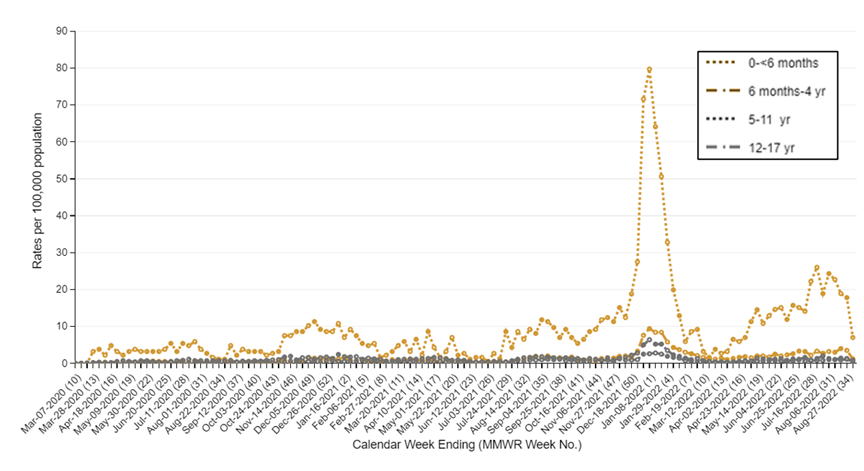
The Coronavirus Disease 2019 (COVID-19)-Associated Hospitalization Surveillance Network (COVID-NET) is an additional source for hospitalization data collected through a network of more than 250 acute-care hospitals in 14 states (representing ~10% of the U.S. population). Detailed data on patient demographics, including race/ethnicity, underlying medical conditions, medical interventions, and clinical outcomes, are collected using a standardized case reporting form.
Deaths
The current 7-day moving average of new deaths (314) has decreased 28.1% compared with the previous 7-day moving average (437). As of September 7, 2022, a total of 1,043,921 COVID-19 deaths have been reported in the United States.
1,043,921
Total Deaths Reported
1,043,921
Total Deaths Reported
314
Current 7-Day Average*
314
Current 7-Day Average*
437
Prior 7-Day Average
437
Prior 7-Day Average
-28.1%
Change in 7-Day Average Since Prior Week
-28.1%
Change in 7-Day Average Since Prior Week
*Historical deaths are excluded from the daily new deaths and 7-day average calculations until they are incorporated into the dataset by their applicable date. Of 21,783 historical deaths reported retroactively, 27 were reported in the current week; and none were reported in the prior week.
Daily Trends in Number of COVID-19 Deaths in the United States Reported to CDC

7-Day moving average
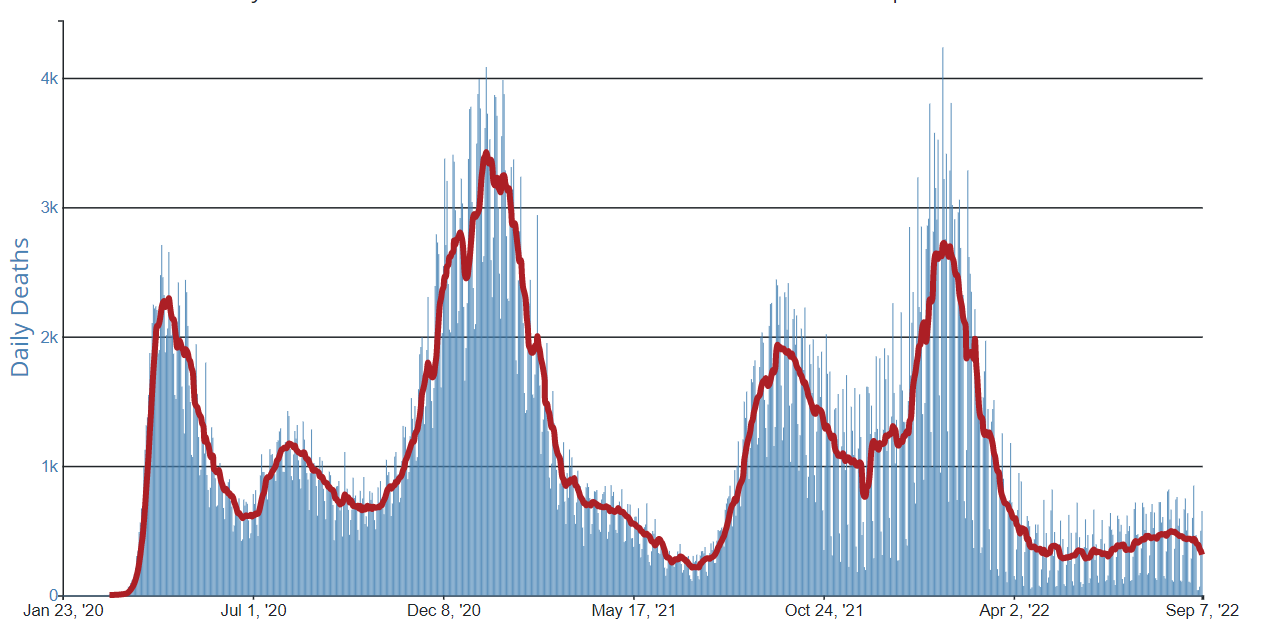 More Death Data
More Death DataTesting
The percentage of COVID-19 NAATs (nucleic acid amplification tests)* that are positive is decreasing in comparison to the previous week. The 7-day average of percent positivity from NAATs is now 13.2%. The 7-day average number of tests reported for August 26–September 1, 2022, was 466,849, down 9.1% from 513,596 for the prior 7 days.
952,398,537
Total Tests Reported
952,398,537
Total Tests Reported
466,849
7-Day Average Tests Reported
466,849
7-Day Average Tests Reported
13.2%
7-Day Average % Positivity
13.2%
7-Day Average % Positivity
13.5%
Previous 7-Day Average % Positivity
13.5%
Previous 7-Day Average % Positivity
-.33
Percentage point change in 7-Day Average % Positivity since Prior Week
-.33
Percentage point change in 7-Day Average % Positivity since Prior Week
*Test for SARS-CoV-2, the virus that causes COVID-19
Wastewater Surveillance
COVID Data Tracker’s Wastewater Surveillance tab tracks levels, changes, and detections of SARS-CoV-2* viral RNA in wastewater at over 1,000 testing sites across the country.
Currently, most of the country is reporting moderate to high SARS-CoV-2 levels in wastewater. About 27% of sites reporting wastewater data are currently seeing some of the highest levels for those sites since December 1, 2021. About 56% of sites are experiencing a decrease in SARS-CoV-2 levels, and about 38% are reporting an increase. It’s important to note that even a small increase when levels are low can appear like a dramatic increase in the percent change.
For more information on how to use wastewater data, visit CDC’s website.
*The virus that causes COVID-19
SARS-CoV-2 Levels in Wastewater by Site


0% means levels are the lowest they have been at the site; 100% means levels are the highest they have been at the site.


